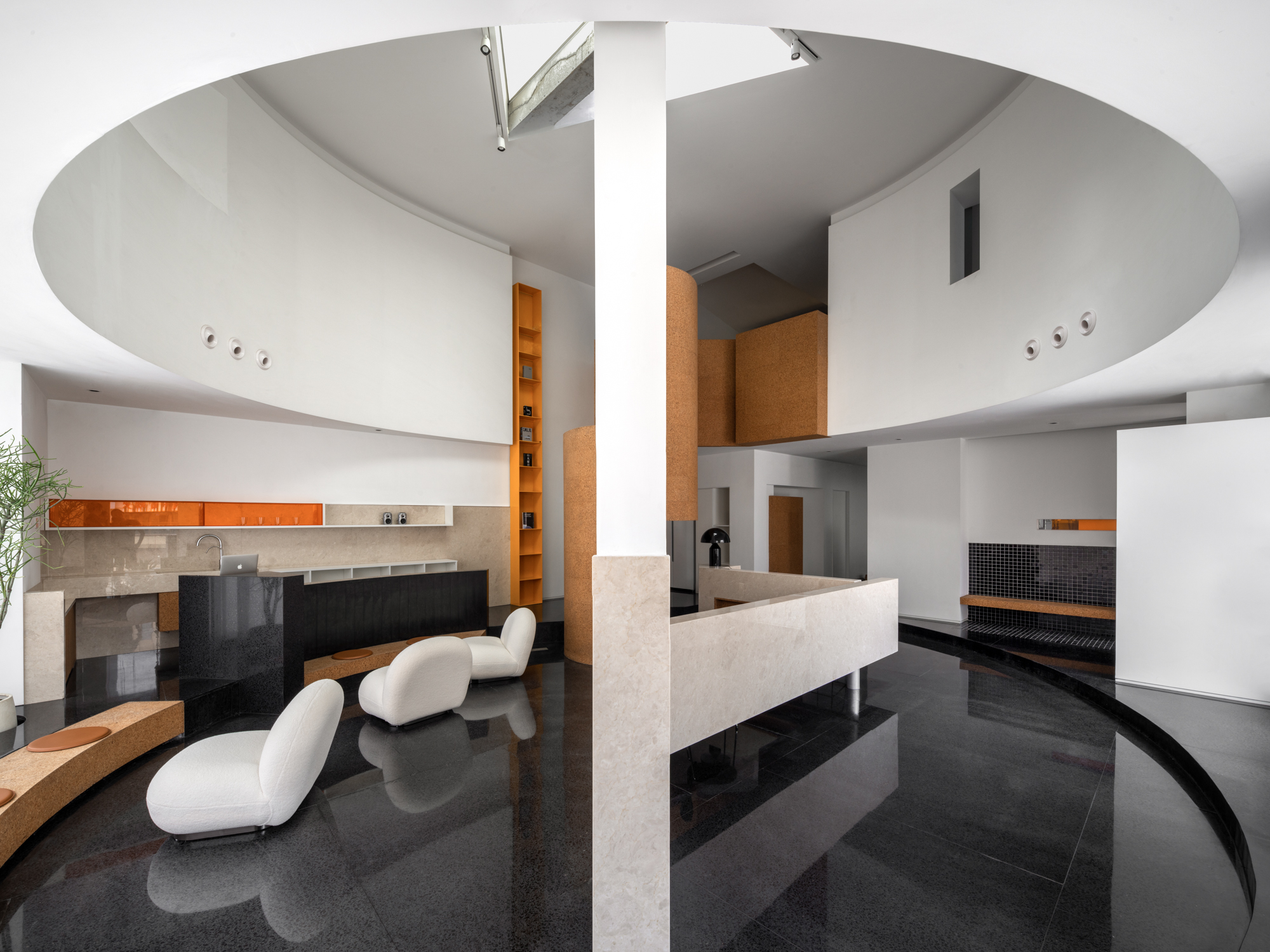
设计单位 边界空间设计
项目地点 江苏常州
完成年份 2022年
建筑面积 500平方米
世上大多的事物都是矛盾又统一的吧。诸如黑白明暗、天地山河、动静冷热,又如瑜伽中的身体与精神、体式与冥想,也如空间中的造型实体与氛围……
Most things in the world are as contradictory as they are unified, such as black and white, light and shade, heaven and earth, mountains and rivers, movement and stillness, cold and heat, as well as the body and spirit, asana and meditation in yoga. And it is the same in the modeling entity and atmosphere in space...
帕坦伽利在《瑜伽经》中指出,体位法具有两个重要的特质:“住”(sthirayi[1])与“乐”(sukha[2])。“住”指的是稳定与警觉,“乐”指的是“在某种姿势里保持舒适的能力”。无论我们练习的是哪一种姿势,两种特质都不可偏废。即使已经做到了住的“稳定”与“警觉”,也还应达成乐的舒适与轻快,而且两者都要能持久。
Patanjali states in the Yoga Sutras that asanas have two important qualities: sthirayi and sukha. Sthirayi refers to stability and alertness, and sukha refers to the ability to remain comfortable in a certain posture. No matter which postures we practice, neither of these qualities can be neglected. Even if you have achieved stability and alertness of Sthirayi, you should also achieve the comfort and lightness of sukha, and both of them must be durable.
——《瑜伽之心》[3]
我们对瑜伽习练空间的设定,也秉持相通的内在动力。好的瑜伽空间,应不只是一个专业瑜伽的习练场地,还要让习练者与空间有“乐”的联结。
Our setting of yoga practice space also adheres to the same internal motivation. A good yoga space should not only be a professional yoga practice venue, but also allow practitioners to have a sukha connection with the space.
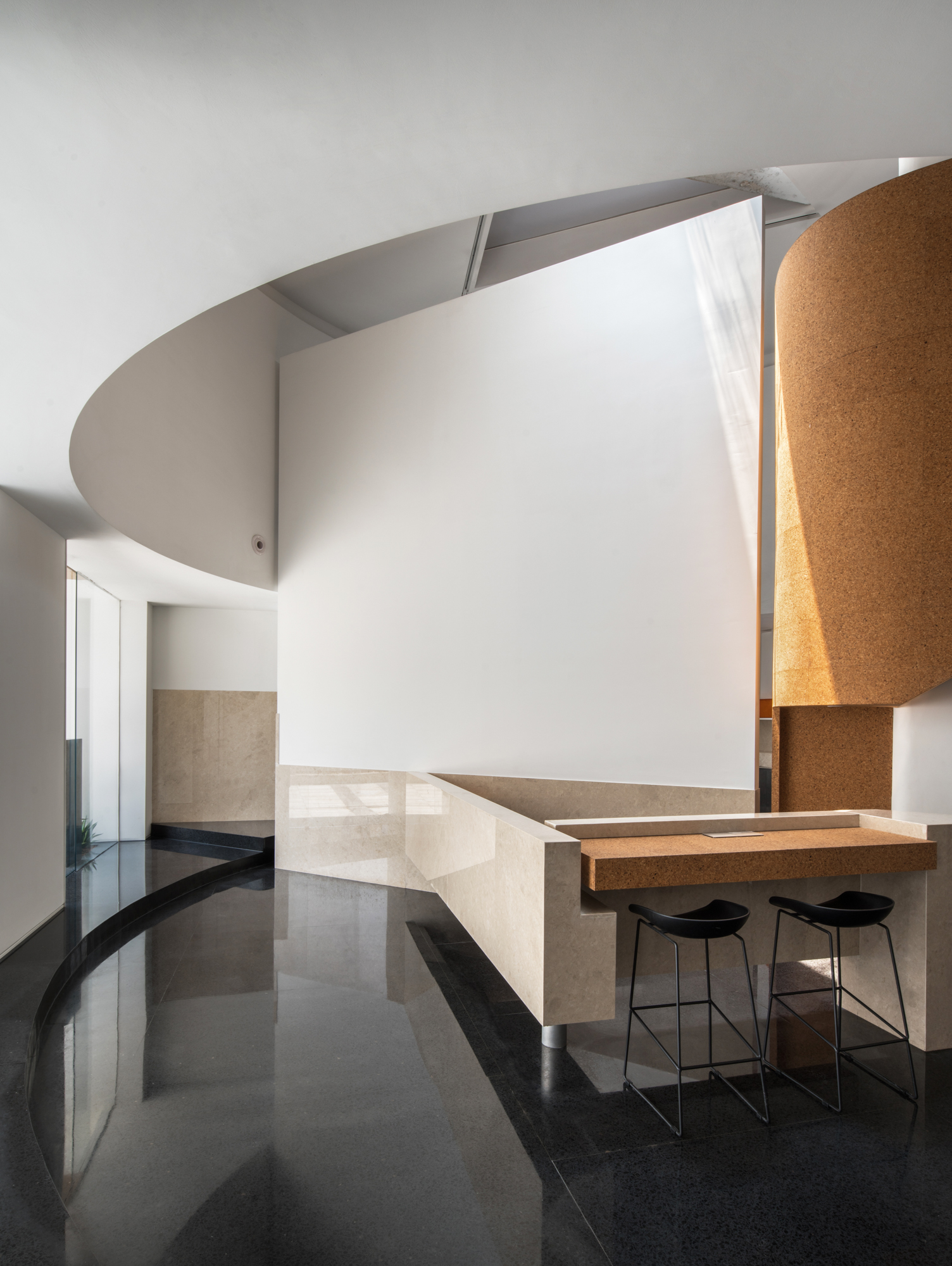
项目位于数个低层建筑散落而成的商业城中心区域,占据所属单体建筑南侧,分上下两层:一层的三面按间设门。二层东南装有灰色玻璃幕墙向外悬挑,西侧广告位间隙有两个小窗。整个建筑形似三个体块粗犷的并集,与整个商业城有着统一表皮。
The project is located in the central area of a commercial city where several low-rise buildings are scattered, occupying the south side of the single building to which it belongs, and is divided into two floors: Doors are set according to the rooms on three sides of the first floor. The southeast of the second floor is equipped with a gray glass curtain wall that projects outwards, and there are two small windows between the advertising space on the west side. The whole building resembles a rough union of three blocks, and has a unified skin with the entire commercial city.
内部空间挑空无柱,由于二层挑出,南侧窗口外的光线只能探进一步,而西侧两个高窗射进的光线锋利自由,时间改变着光影打在建筑上的位置。驻于原始场地,虽满眼皆是窗,心中却黯然。
The high-rise interior space is without columns, and due to the second floor’s projecting out, the light outside the window on the south side can only penetrate one step, while the light from the two high windows on the west side is sharp and free, and time changes the positions of light and shadow on the building. Standing in the original venue, although all that eyes could see are windows, the view is still dim.

我们将所有习练室贴近采光侧,除去入口玻璃移门,一层所有原始开门均替换成固定玻璃,门洞便成为窗口。二层玻璃幕墙区域,我们在玻璃幕墙表面散布的装饰方通基础上,依据原始散落秩序设了同色横档,白色波浪半透阳光板敷于之上,来隔绝原始外立面大比重的灰玻,再一次柔化光线。我们还将LOGO后置于阳光板,最大面的原始表皮被消隐掉。阳光板下挂超出玻璃面,像裙摆,虚化与一层的交错。上下檐口不做封堵,阳光板与幕墙间形成风压,增加窗的通风量。
We put all the classrooms close to the daylighting side, remove the glass sliding doors at the entrance, and replace all the original doors on the first floor with fixed glass, and the door openings become windows. In the area of the second-floor glass curtain wall, on the basis of the decorative square tubes scattered on the surface of the glass curtain wall, according to the original scattering order, the same color rails are set up, and the white wave translucent sunshine board are applied on the top to isolate the gray glass of the original façade with a big proportion, softening the light again. The LOGO is placed behind the sunshine board, and the original skin on the biggest surface is blanked out. The sunshine board hangs beyond the glass surface, like a skirt, blurring its interlacing with the first floor. The upper and lower cornices are not blocked, forming a wind pressure between the sunshine board and the curtain wall to increase the ventilation of windows.
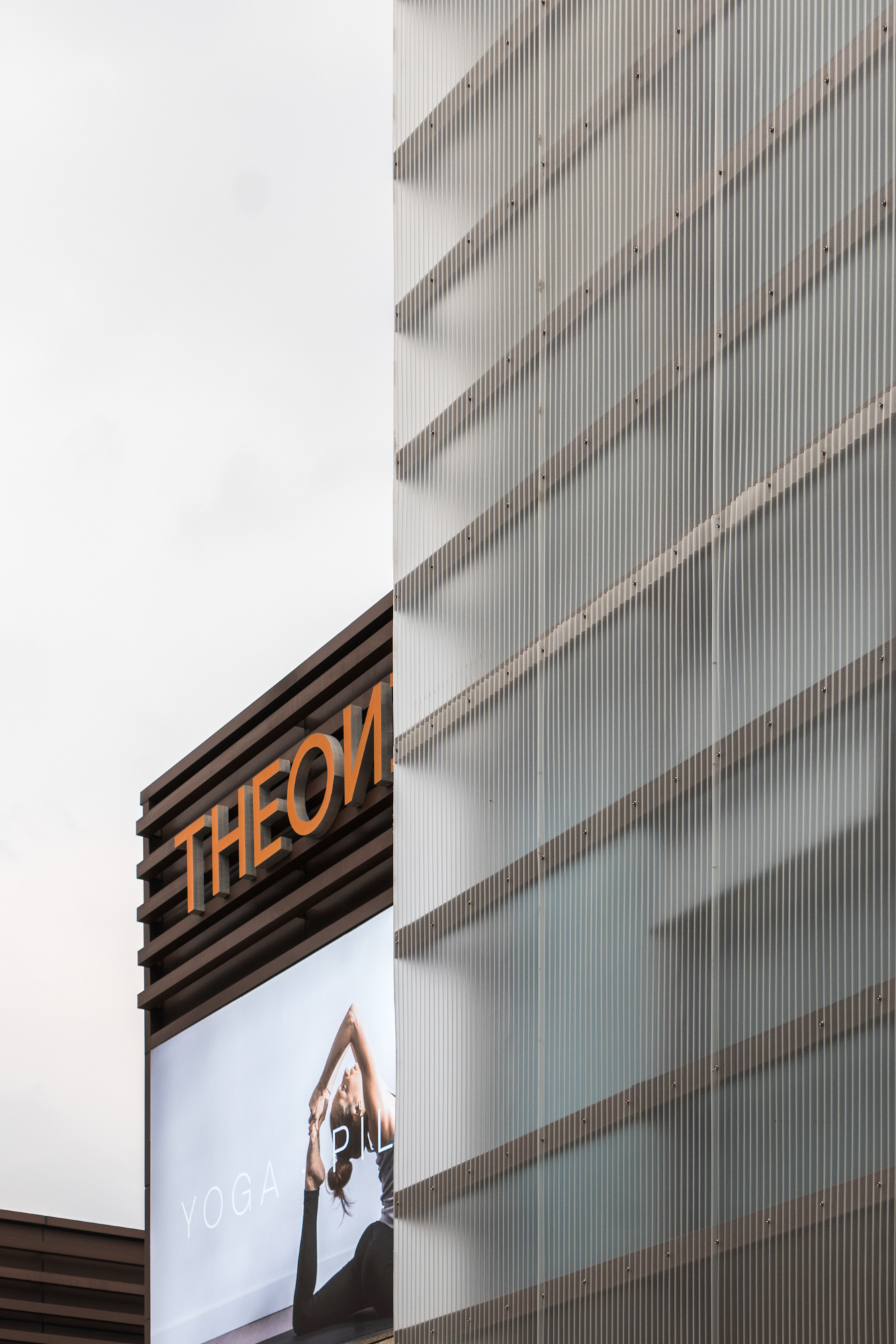
入口作为内外空间的联结点,决定以什么样的视角打开内部空间。内部空间的划分排布,决定入口的设立方位。场地三面皆可为入口。我们将习练室分布于上下层靠窗侧,东西侧便留空:西侧空间高挑,作为前区无疑是最合适的选择,入口便也依附于前区而设;东侧剩余空间,采光较差,一层设为卫生间、更衣区、保洁间,二层最深处无疑适合冥想空间。正如瑜伽中对呼吸方式的建议,“在吸气的时候,先将气吸入胸部、再吸入腹部;而在呼气的时候,先排出腹部的空气,再让胸腔内上肺叶的空气最后排出。”[4]我们的前区就是这“L”形空间的胸腔,往后便是腹部。
The entrance serves as the connection point between the interior and exterior space, and decides what perspective to open the interior space. The division and arrangement of the internal space determine the orientation of the entrance and the entrance is available on three sides of the venue. We distribute the classrooms by the windows on the upper and lower floors, leaving the east and west sides empty: the space on the west side is a high-rise, which is undoubtedly the most suitable choice as the front area, and the entrance is also attached to it; The remaining space on the east side has poor lighting, which is set as bathrooms, dressing areas, and cleaning rooms on the first floor. And the deepest part of the second floor is undoubtedly a space for meditation. As suggested in yoga for breathing methods, when inhaling, first inhale the air in the chest and then in the abdomen; when exhaling, exhale the air out the abdomen first, and then exhale the air out the upper lobes of the chest last. Our front area is the chest of this L-shaped space, and then the abdomen.
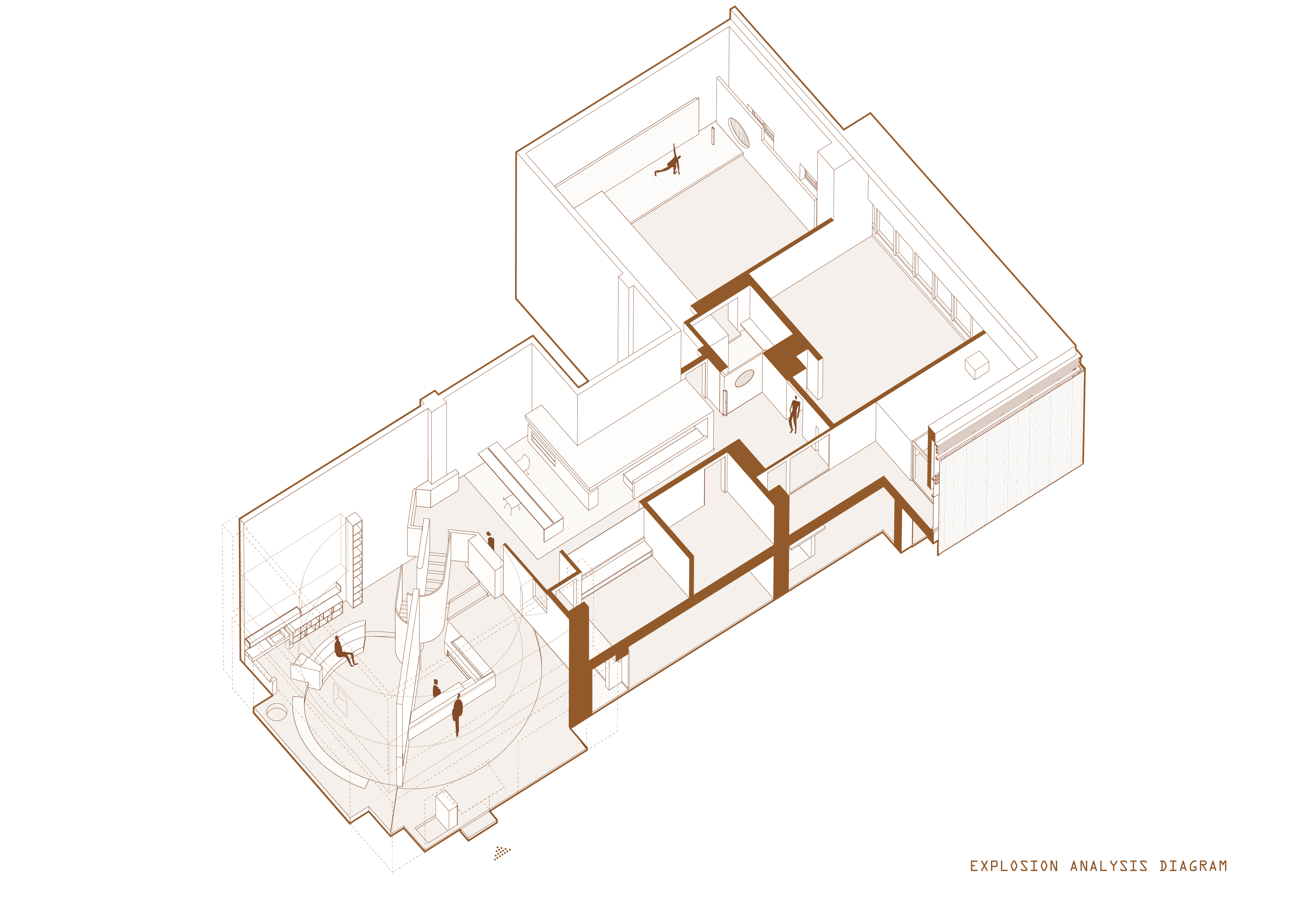
前区的排布,围绕一座“园”展开。前区是外挂于上下两层空间一侧的园,一座盛放身体与精神的园,呈方形,被中心升起的片墙二分,前园接待,后园休憩,二分空间功能属性,又二分习练者不同精神状态。
The layout of the front area unfolds around a garden. The front area is a garden that hangs on the side of the upper and lower floor space, a garden for the body and spirit. It is square-shaped and divided into two parts by a rising nonbearing wall in the center. The front garden for reception and the back garden for rest, dichotomizing spatial functional attributes as well as the different mental states of practitioners.
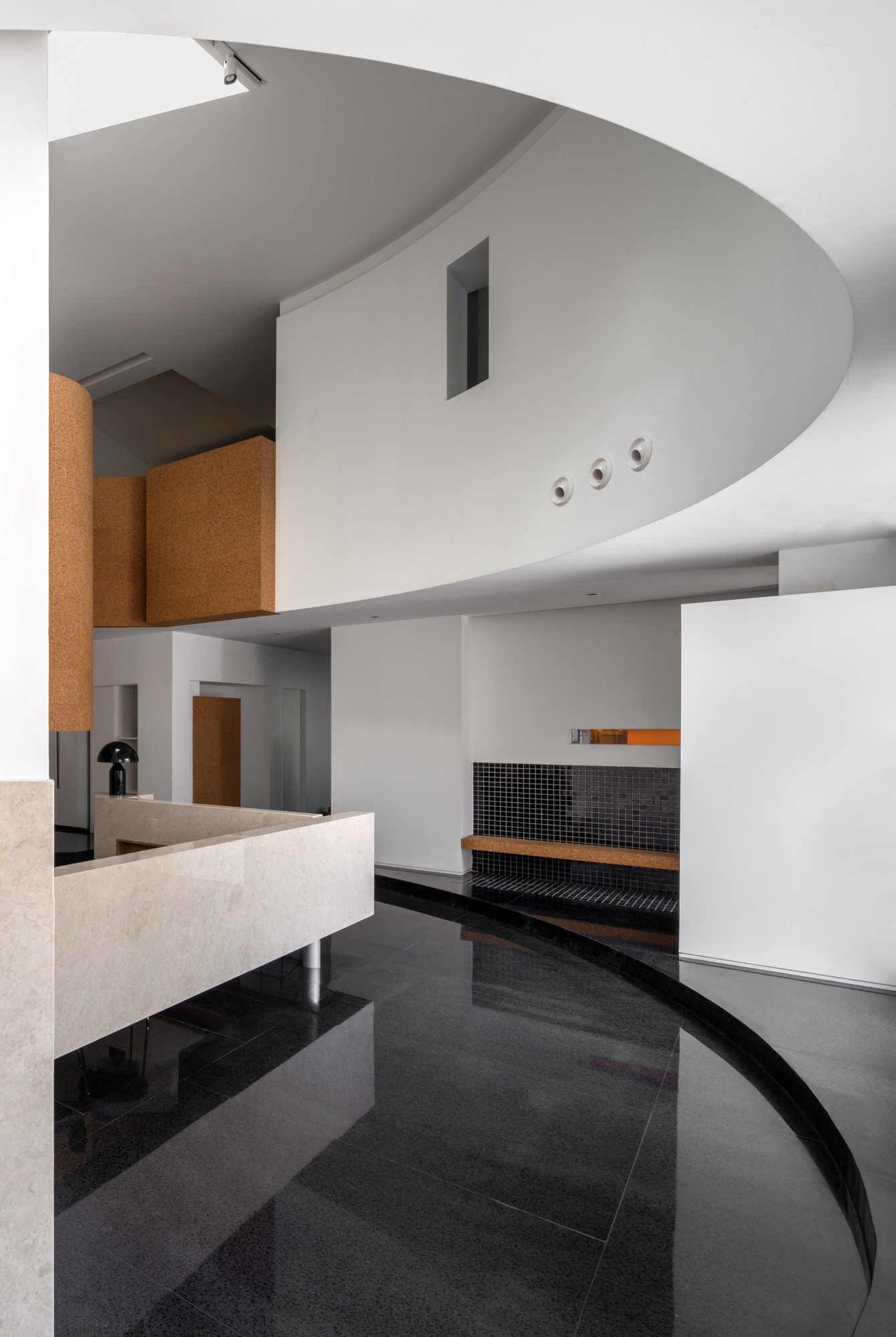
墙从地面生根,三边均不与周边相接,前后端自然流出两个窄缝,联结两侧,墙像是可自由旋转的拨钮。园顶面环园围合,地面水磨石呼应顶面环形抬高。后园靠窗一段水磨石,嵌入软木成为坐台,后段提升高度,为高坐台靠背,又是软木小讲台的前沿。讲台面对大墙,与水吧共用一块空间,大墙成为最佳投影幕布。
The wall is rooted from the ground, and the three sides are not connected to the surroundings, leaving two narrow slits naturally at the front and rear ends to connect the two sides. The wall is like a freely rotatable knob. The top surface encloses the garden, and is echoed by the ground terrazzo of a circular elevation. There is a section of terrazzo by the window in the back garden, which is embedded in cork to become a seat. The rear section is raised to a height and used as the backrest of the high seat, and is also the front of a small cork podium. The podium faces the big wall and shares one space with the water bar. And the big wall becomes the best projection screen.

后园中心区域散落几张沙发,整个休息区轻快、舒适。前园从墙挑出一个三角形吧台,两边分别平行于所服务区域的边线,看似墙的脚,却悬而未落。驻于入口缝隙前望向墙,极窄,墙全然不在,成为两个空间最近的相遇面,两个空间可同时入目,其间游走于前园的习练者与放松谈笑于后园的习练者互不影响,对立又统一的空间充满戏剧感。
There are several sofas scattered in the central area of the back garden, and the whole seating area is light and comfortable. A triangular bar stands out from the wall in the front garden, and the two sides are parallel to the edge of the servicing area. It looks like the foot of the wall, but it hangs. Standing in front of the entrance gap and looking at the wall, it is very narrow, and the wall is completely absent, which becomes the closest meeting surface of the two spaces. The two spaces can be seen at the same time, and practitioners wandering in the front garden and practitioners chatting and laughing in the back garden do not affect each other. The space of opposition and unity is full of drama.

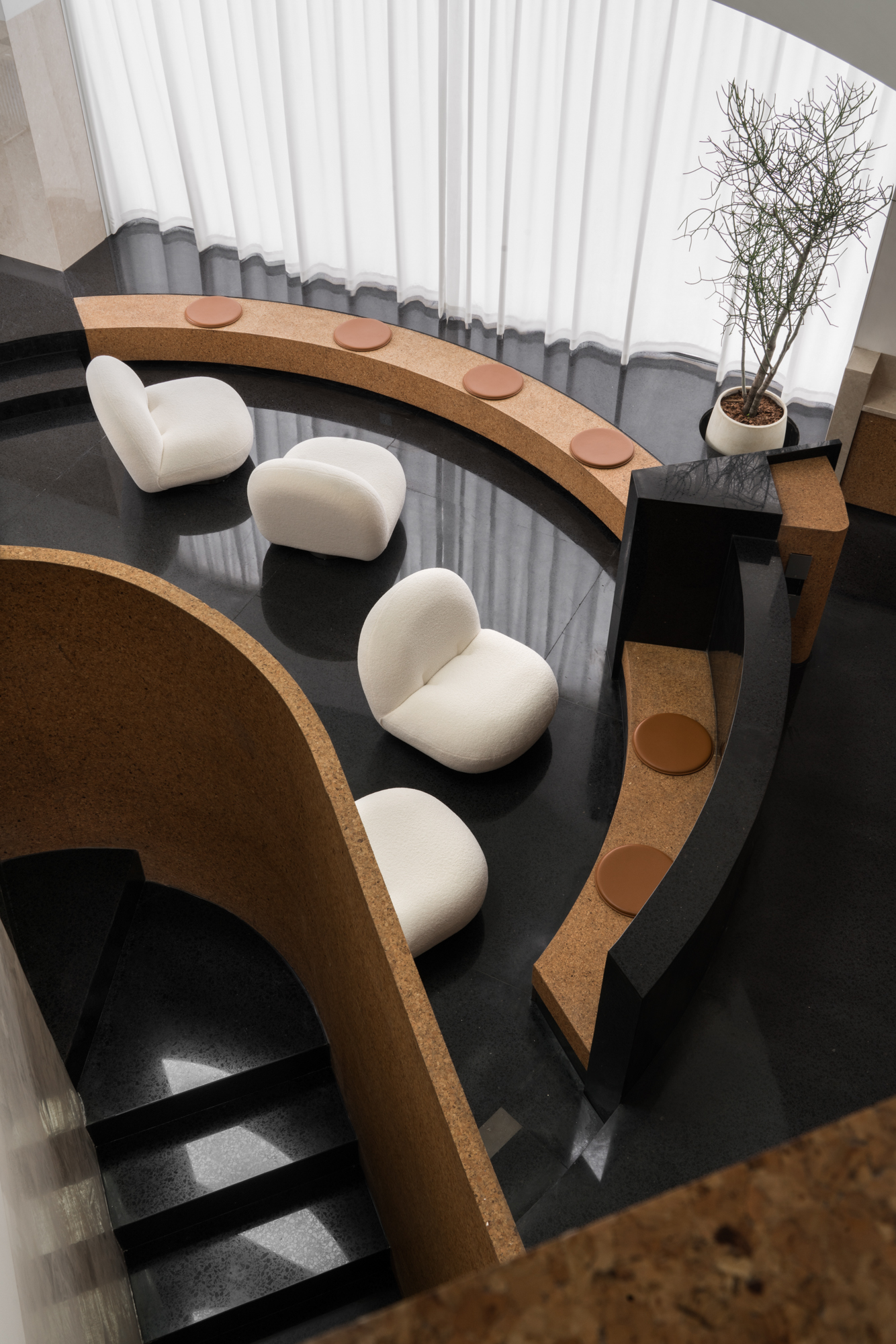
墙后端有“裂谷”,极窄楼梯悬于之上,以软木围合,途中有一处踏步两步合一,形成小平台,软木随行避开。习练者盘绕“山”中,视线可游离于两侧空间。登楼侧身之间又见一方景象。
There is a rift valley at the rear end of the wall, and a very narrow staircase is hung above it, enclosed by cork. On the way, there is a step where two steps are combined into one to form a small platform, and the cork avoids it. When practitioners swirl the mountain, the sight can be free in the space on both sides, seeing a new scene when climbing the staircase.
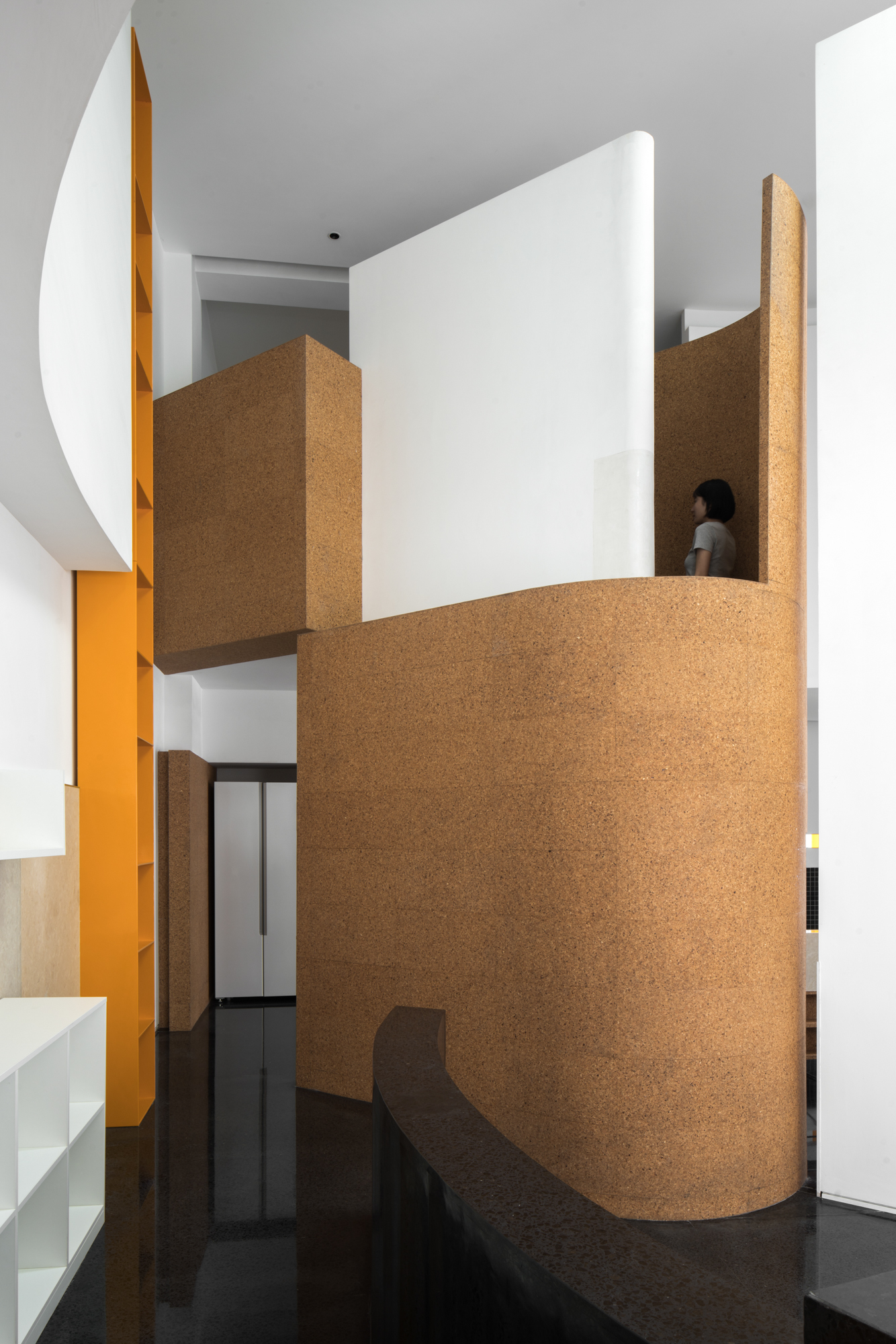
墙是两个区域的相遇面。“光”就是两个区域的结合点。
The wall is the meeting surface of the two areas. And light is the juncture of them.
虽然整个前区充满了阳光,但有大墙的分隔,两侧光成为单个区域的专属,大墙垂直向上的压迫感,能让天空出现,加入不属于两侧的光,成了迫切的渴望。所以我们在大墙中心正上方,开了一方三角形天窗,三角旋转与“山”的走势形成45°夹角,天窗被原始结构梁贯穿斜切为两块。考虑夜晚不同区域对光的需求,东侧为通透的天窗,西侧为灯光膜,两边又同属于一个大三角。不论阳光还是人造光源都能跨过“山”照到两个区域。
Although the entire front area is full of sunshine, it is separated by a big wall. The light on both sides becomes exclusive of a single area. The vertical pressure of the big wall makes the appearance of the sky and adding light that does not belong to the two sides become an urgent desire. Therefore, we open a triangular skylight just above the center of the big wall, and it forms a 45° angle with the trend of the mountain. The skylight was penetrated and inclinedly cut into two pieces by the original structural beam. Considering the demand for light in different areas at night, the east side is a transparent skylight, the west side is a light film, and both sides belong to a big triangle. Either sunlight or artificial light can cross the mountain to illuminate both areas.
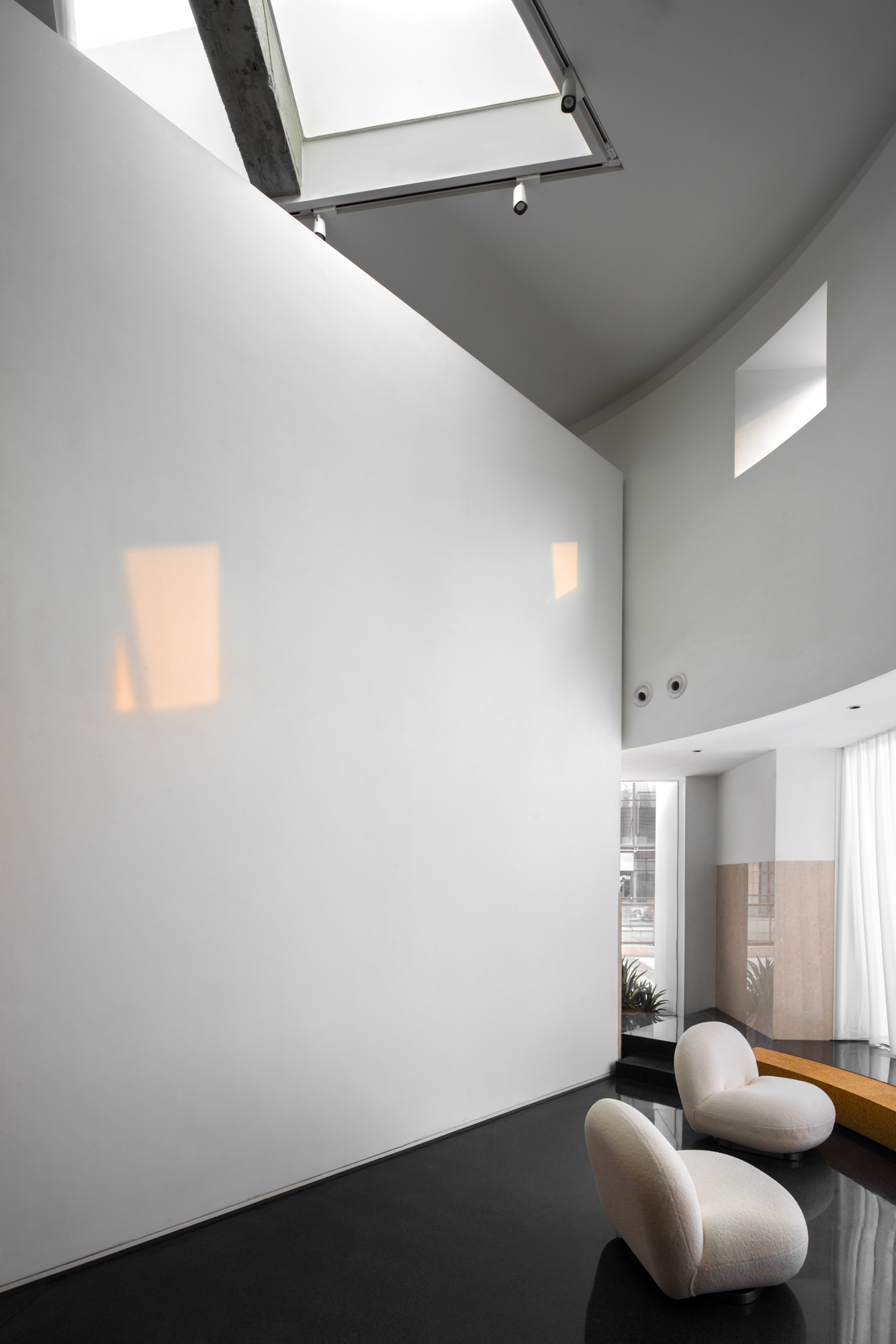
看到太阳光束的升降游移,正如茅盾对《天窗》中的描述“啊唷唷!这小小一方的空白是神奇的!它会使你看见了,若不是有了它你就想不起来的宇宙的秘密;它会使你想到了,若不是有了它你就永远不会联想到的种种事件!发明这‘天窗’的大人们,是应当被感谢的。因为活泼会想的孩子们,会知道怎样从‘无’中看出‘有’,从‘虚’中看出‘实’,比任何他看到的更真切,更广阔,更复杂,更实在!”
Seeing the rise and fall of the sun's light beams is as Mao Tun’s description in Skylight, Ah yo! The blankness of this little one is magical! It will make you see the secret of the universe, which you would not have remembered without it; it will remind you of a variety of events, which you would never have thought of without it! The grown-up who invented this skylight should be thanked. It’s because a lively child with imagination knows how to see something out of nothing and real out of the abstract. They are broader, more complex, and more substantial than anything he has ever seen!
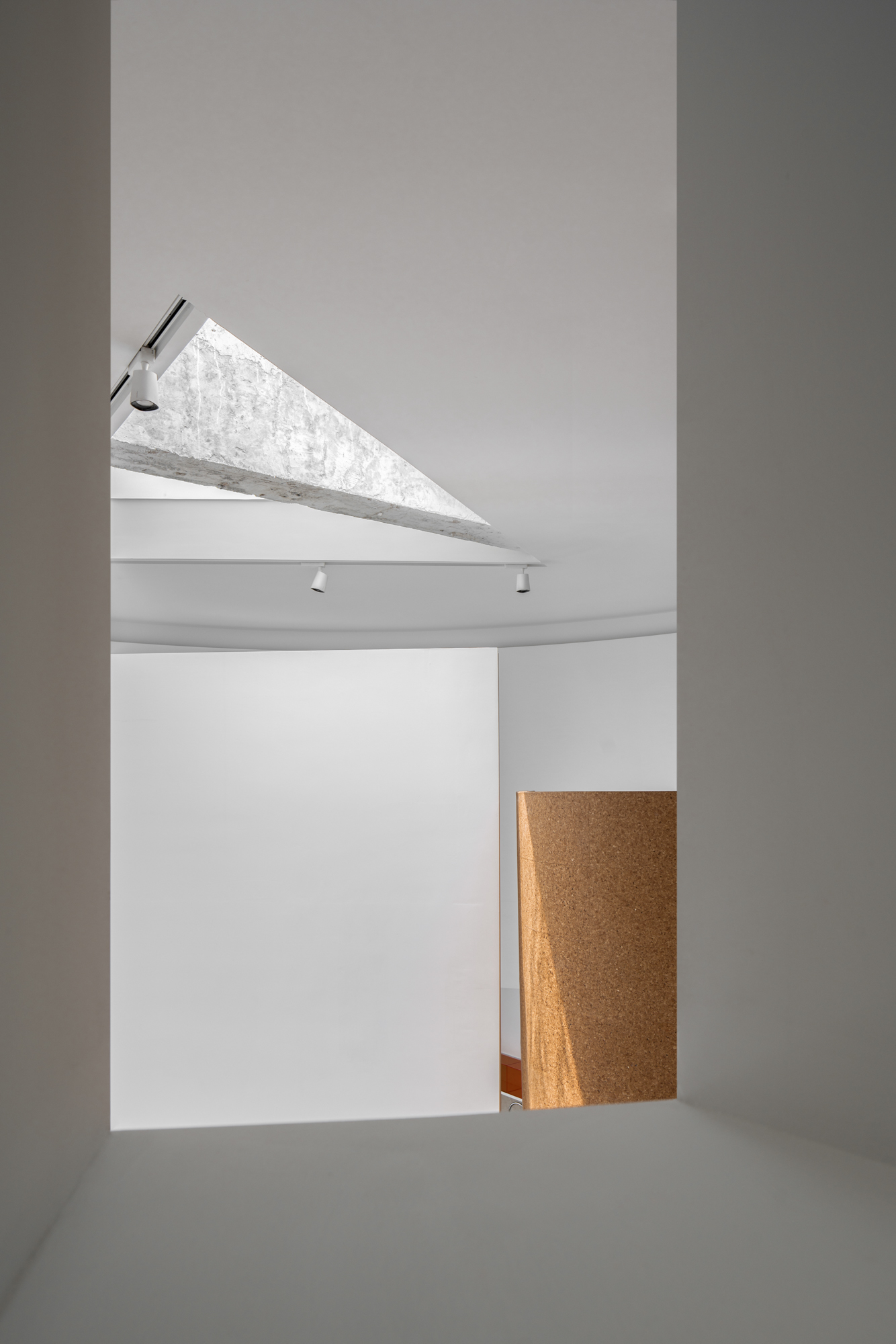
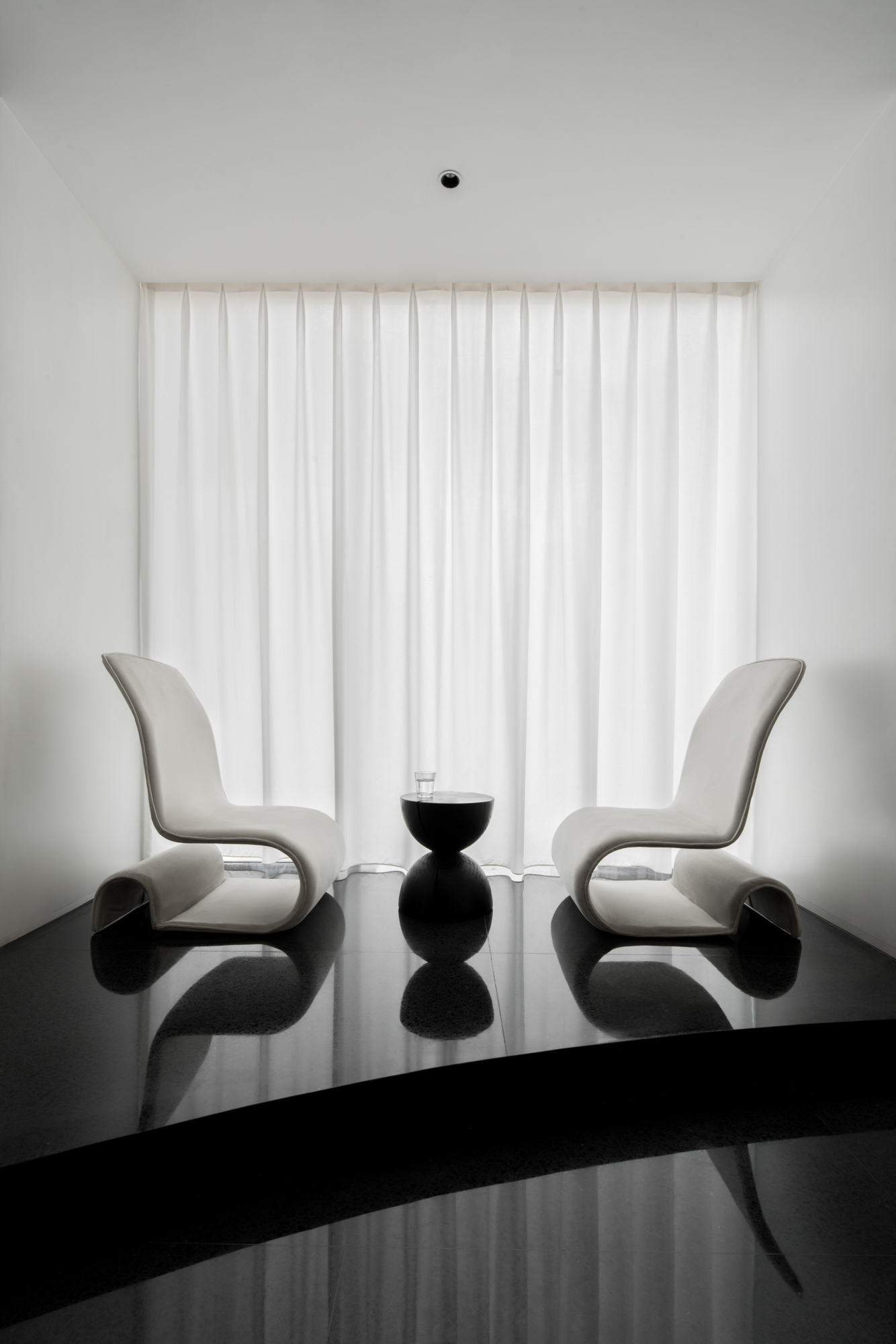
习练室与各功能空间落位后的剩余空间形成的走道,紧贴整个空间的北侧,正是前区到各个功能空间最高效的动线轨迹。通往2号习练室的途径,有1号教室北侧玻璃砖滤过的光,越往深越显深邃。二层空间朝向一层入口划开一个口子,层板为了够到楼梯加的三角形挑出,侧面延续软木围合,与另一侧缺口扶手所划定的两个角落成为向下瞭望最好的观景台。
After the classroom and various functional spaces are set, the walkway formed by the remaining space is close to the north side of the entire space, which is the most efficient moving track from the front area to each functional space. On the way to Classroom 2, there is light filtered by the glass bricks on the north side of Classroom 1, and the deeper it goes, the more profound it becomes. The space on the second floor has an opening towards the entrance of the first floor. The deck is projected out in a triangular shape to reach the staircase. The side is also enclosed by a cork. And the two corners delimited by the handrail gap on the other side are the best places to look down.


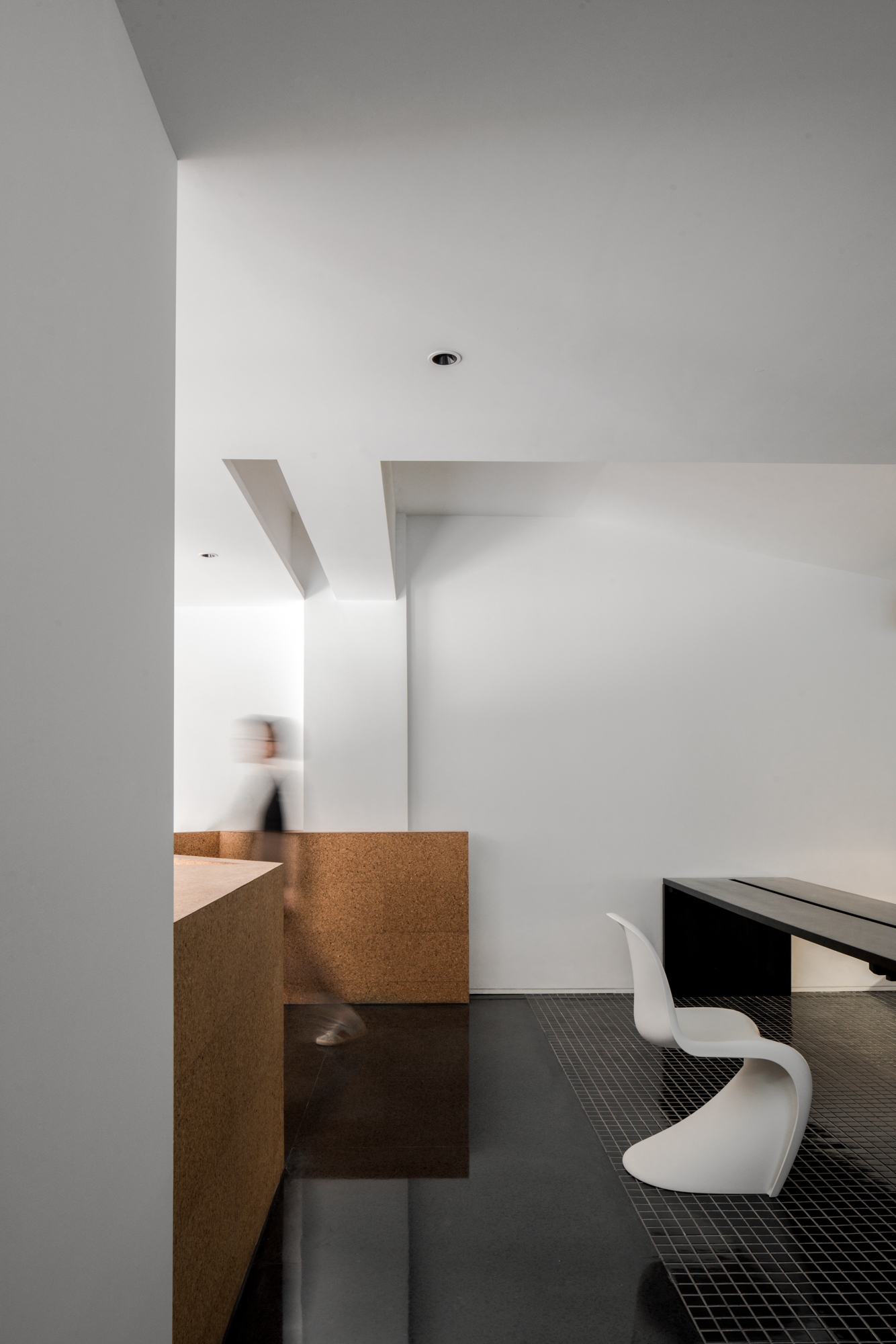
二层嵌入墙体的休息区同样是习练室与办公室划分后的剩余空间,较大区域放置长桌,空出宽裕的走道空间,地面马赛克向后区延续,设立软木吧台,吧台向顶面折叠的软木,切于原始建筑突出的转角墙面与向上拉斜的吊顶。靠墙的石材墙柜,也向后区延续,与软木吧台同样停止于储藏间门口。
The seating area embedded in the wall of the second floor is also the remaining space after the division of classrooms and the office. A long table is placed in the big area, leaving ample walkway space. The floor mosaic continues to the back area, and a cork bar is set up. The cork folded to the top of the bar is cut into the protruding corner wall and the upward-sloping ceiling of the original building. The stone wall cabinet against the wall also continues to the back area, and stops at the door of the store room like the cork bar.
对于光,二层裂口处,有从一层和西侧高处的窗,散射过来的光线,走道右侧是两间VIP习练室,靠休息区的一间做了半透毛玻璃,后区尽头的办公区全透玻璃与普拉提习练室的半透移门,也都让光线涌入。反而我们在水吧侧的VIP习练室做了封闭。晦明变化间,习练者通过走道,双向都是向光而行。前端让休息区更加通透,后端在保证光亮的同时也为冥想室埋下伏笔。
For light, at the split on the second floor, there is scattering light from windows on the first floor and high places on the west side. On the right side of the walkway are two VIP classrooms, one near the seating area is equipped with semi-transparent frosted glass. The fully transparent glass of the office area at the end of the back area and the semi-transparent sliding door of the Pilates classroom also let in light. Instead, closures have been done to the VIP classroom on the side of the water bar. During the change of shade and light, practitioners walk through the walkway, facing the light in both directions. The front end makes the seating area more transparent, and the back end not only ensures the light, but also lays the groundwork for the meditation room.
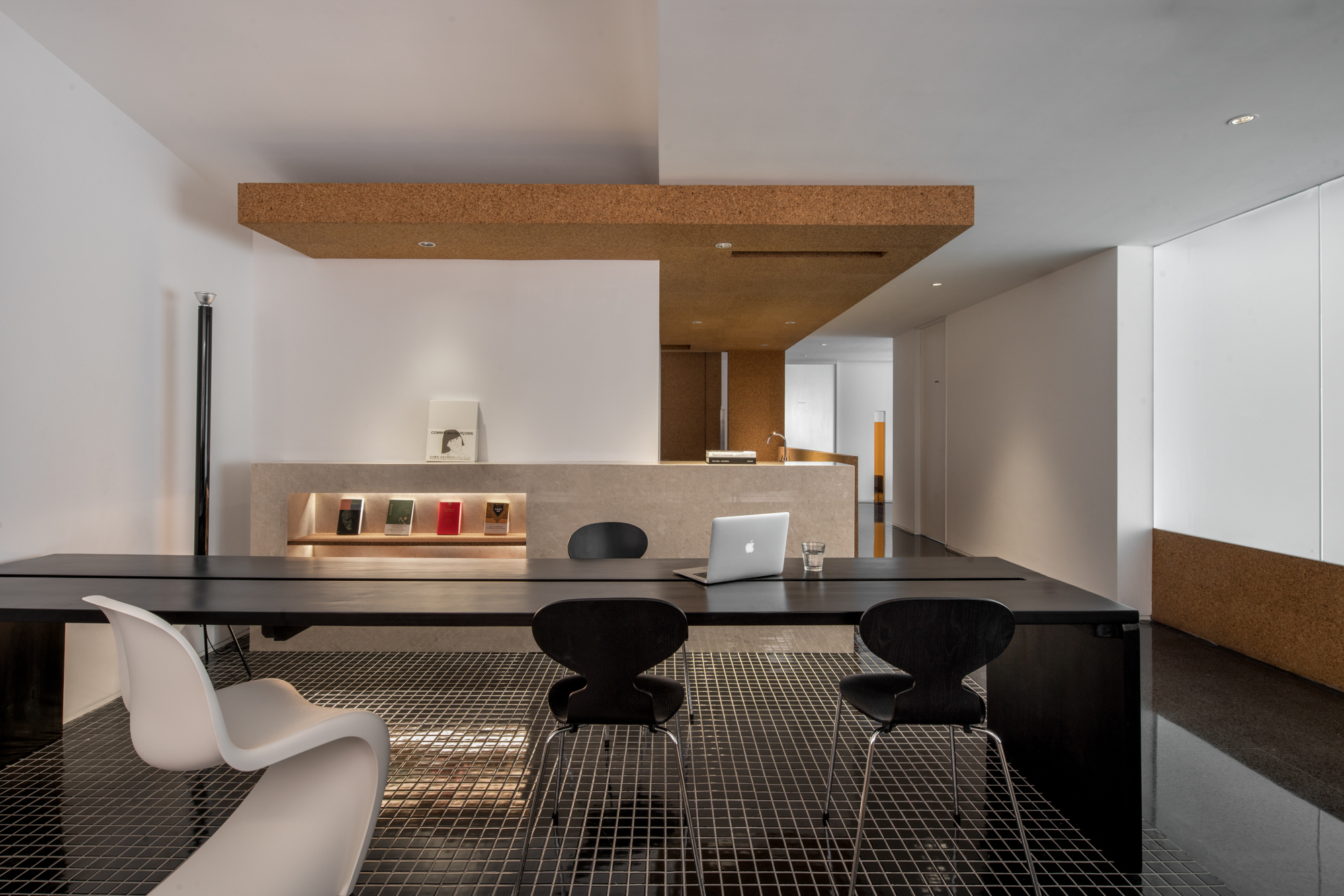

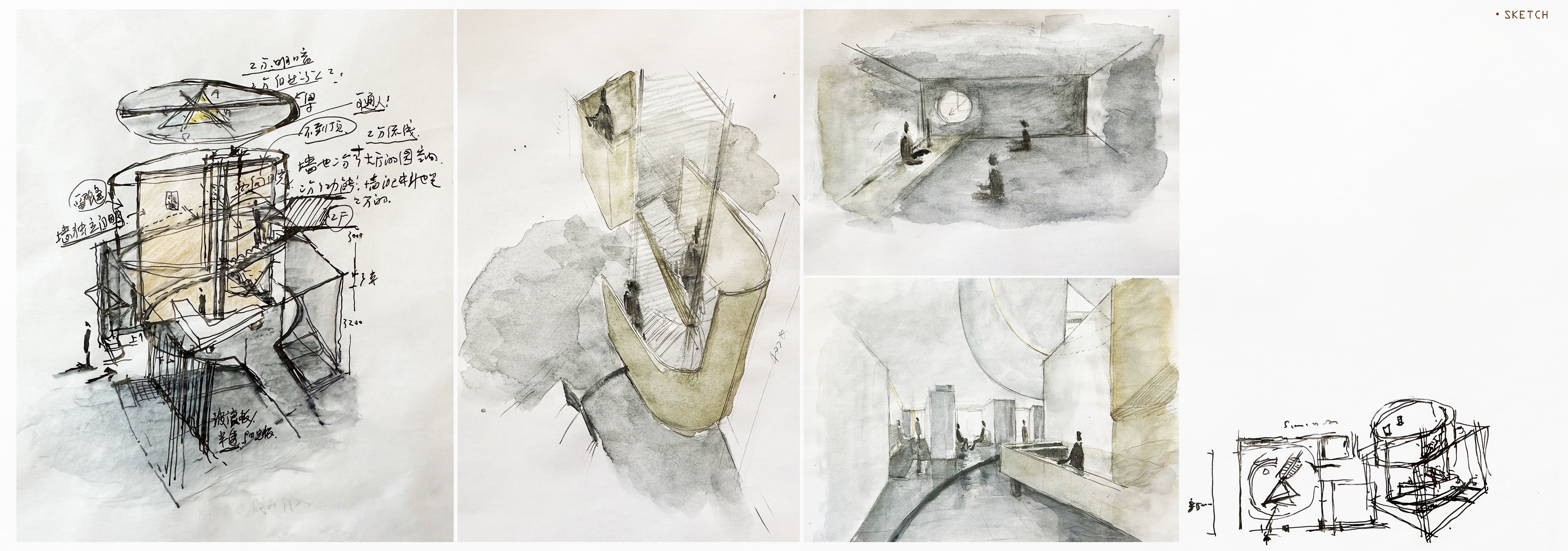
接待区东侧,一块区域被马赛克覆盖,横一个软木坐台,供使用者换鞋与休息等候。马赛克地面藏进不到顶的墙体后,向右侧引导,转身进入便是1号习练室。
On the east side of the reception area, an area is covered with mosaics, and there is a cork seat for users to change their shoes and wait for a rest. After the mosaic floor is hidden in the wall that does not reach the top, it is guided to the right, turning around and entering Classroom 1.
习练室两片斜顶压在窗的上口向北侧照射,透过北侧的玻璃砖侵入过道。黑色地板延续公区色调。墙上橙色半透亚克力的视窗,是习练室与公区的另一个连接点。
The two sloping roofs of the classroom are against the upper opening of the window for illuminating the north side and penetrating the walkway through the glass bricks on the north side. The black floor continues the tone of the public area. The orange translucent acrylic window on the wall is another connection point between the classroom and the public area.
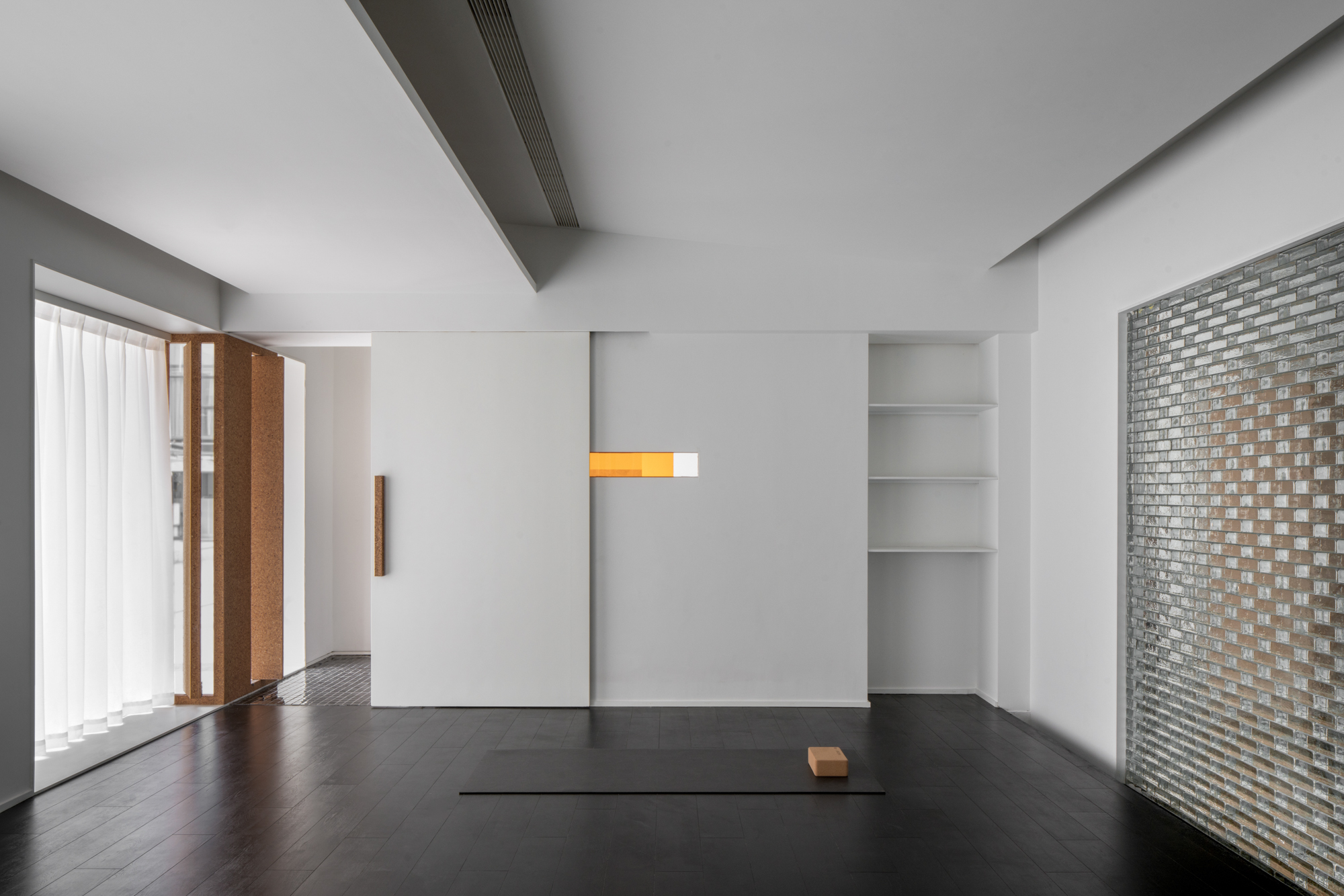
2号习练室是最大的习练室,同走道宽度的入口作为该习练室的预进区。习练室主背景墙上端下压,向外探到预进区与外部走道的上部空间。顶部在原始钢梁基础上下挂横板,两侧放置灯带,形成的条形照明系统伸进夹缝,空间的错位让习练室视觉延续。奇妙的是,习练者像是出入于一个长条盒子,而习练于一个更大的广场……
Classroom 2 is the biggest classroom, and the entrance of the same width as the walkway serves as the pre-entry area of the classroom. The top of the main background wall of the classroom is hanging down, and reaching out to the upper space of the pre-entry area and the external walkway. On the top, horizontal plates are hung down on the basis of the original steel beam, and light strips are placed on both sides, forming a strip lighting system reaching into the slit. The malposition of space lets classroom vision continue. The strange thing is that practitioner seems to come in and out of a long box and practice in a bigger square…

两间VIP习练室顶面中心横穿一根大梁,在靠窗侧的顶面向上倾斜,用软木饰面;另一侧隐藏大梁和空调设备。窗户口设置香格里拉帘,阳光透过外立面阳光板与帘的双重过滤,柔和轻盈。
The center of the top surface of the two VIP classrooms crosses a girder, and the top surface on the window side is inclined upward, with cork veneer, and the other side hides the girder and air conditioning equipment. Shangri-la blinds are installed at the windows, and the sunlight goes through the double filtration of sunshine boards on the façade and the curtain, making it soft and tender.

普拉提习练室,由于空间内会使用瑜伽器械,顶面没有过多层级,保证充足的习练空间,并且顶面只用线性灯带防止眩光。
In the Pilates classroom, since yoga equipment will be used in the space, there are not too many layers on the top surface to ensure sufficient practice space, and only linear light strips are used on the top surface to prevent glares.
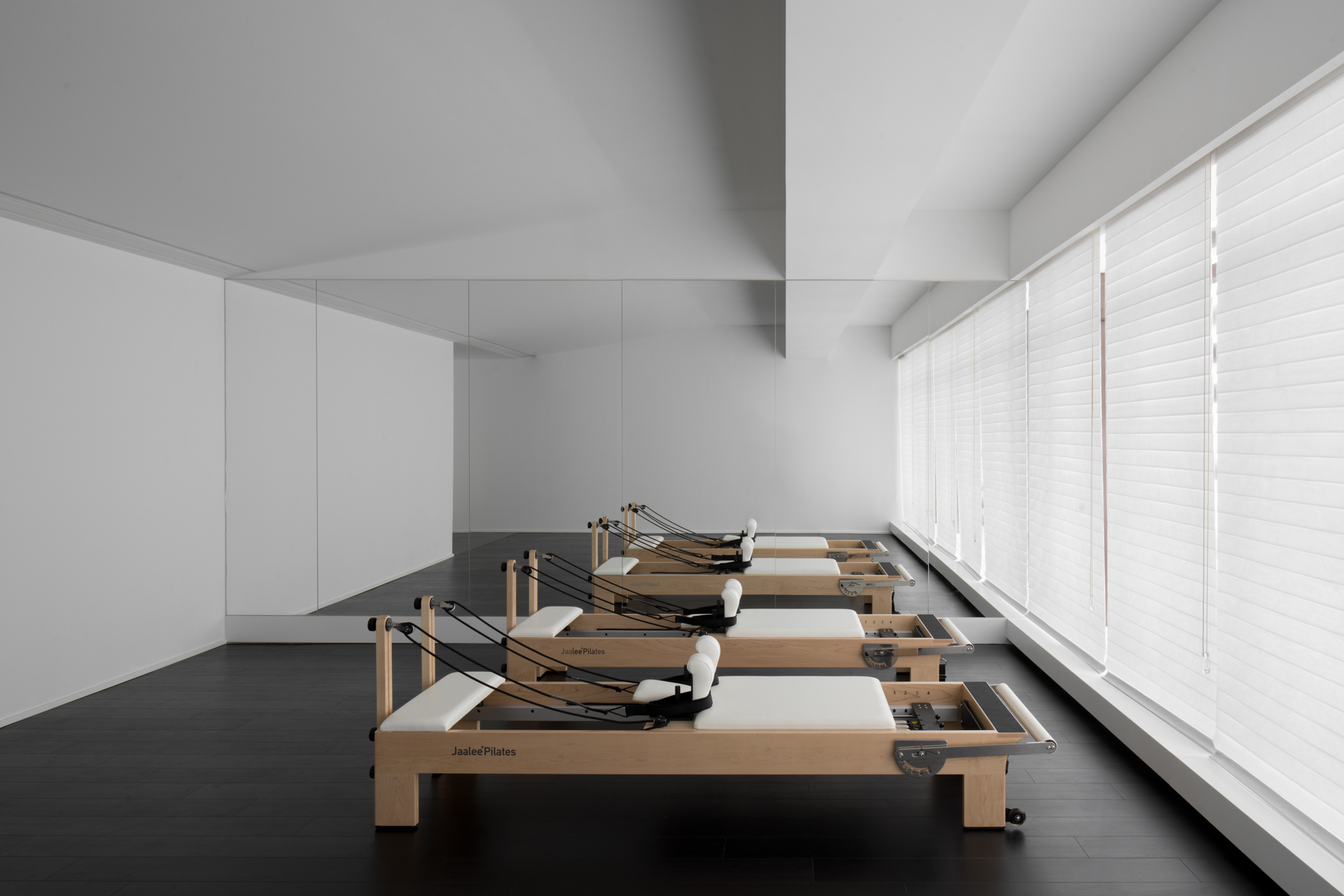
隐,不是与外界完全割裂,而是保持最少的联系。二层走道尽头的软木体块是通往冥想室的入口,用力推开整面墙,便开启一个隐藏的空间。一个存放颂钵的黑色盒子从中探出身体,落在黑色地板上,悬于预进区域的黑马赛克地面。黑色体块不到顶,像是临时放置于此。
Hidden, not completely cut off from the outside world, but to maintain minimal contact. The cork block at the end of the walkway on the second floor is the entrance to the meditation room. Pushing the entire wall will open a hidden space. A black box for a Himalaya bowl protrudes from it and falls on the black floor, overhanging the black mosaic floor of the pre-entry area. The black body does not reach the top, as if it was temporarily placed here.
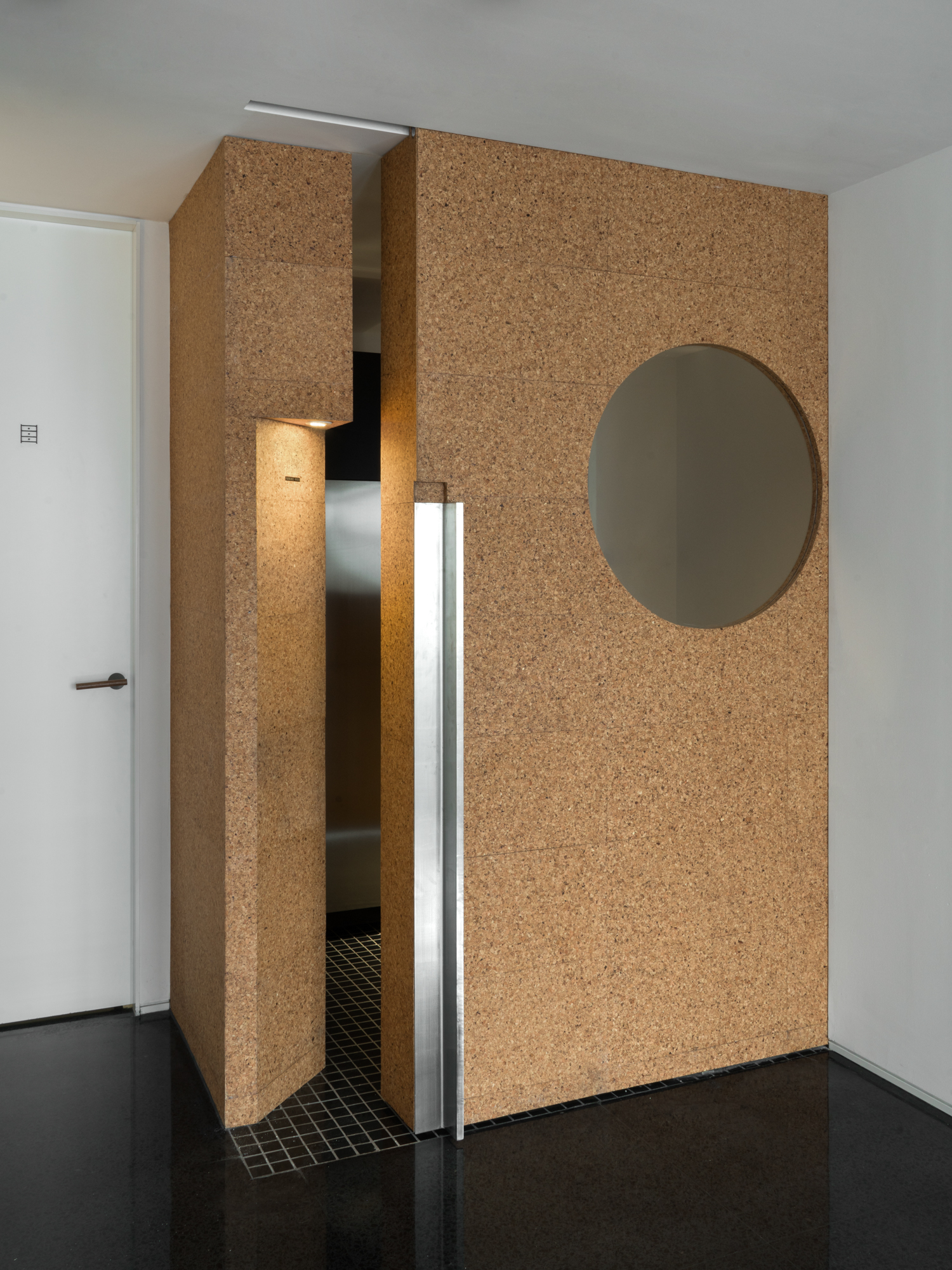
入口对面是整个瑜伽馆习练室中唯一L形软木授课台,地台作用并不是强调授课老师,而是让台下的冥想习练者更沉浸于冥想。侧面悬挂下来的白墙遮住南侧窗,只留一个可以让光线通过的圆洞,并且背后设置了移动阳光板装置,开启可开窗通风,闭合二次滤光。光线斜洒进来打在金属花柱上,享受宁静的自然。授课台左侧伸进黑色体块,体块掏空一侧,一个独立的休息室便出现。
Opposite the entrance is the only L-shaped cork teaching platform in the entire yoga studio. The role of the platform is not to emphasize the teaching teacher, but to make meditation practitioners under the platform more immersed in meditation. The white wall hanging down on the side covers the south window, leaving only a round hole for the light to pass through, and a mobile sunshine board device is set behind it, which can open for ventilation and close for secondary light filtering. The light slants in and hits the metal-style column, making you enjoy the tranquil nature. On the left side of the teaching platform, a black block is inserted. One side of the block is hollowed out, and an independent lounge appears.
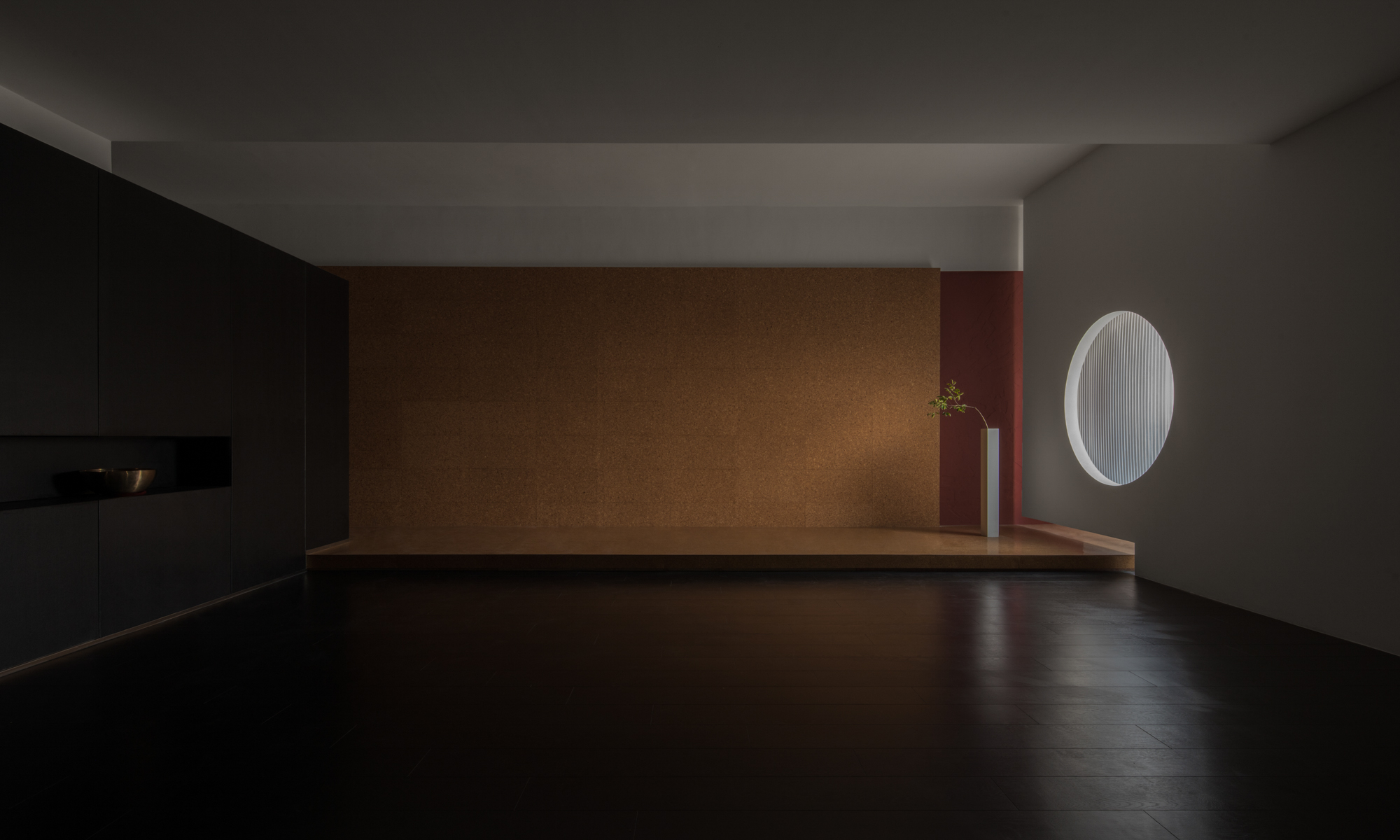
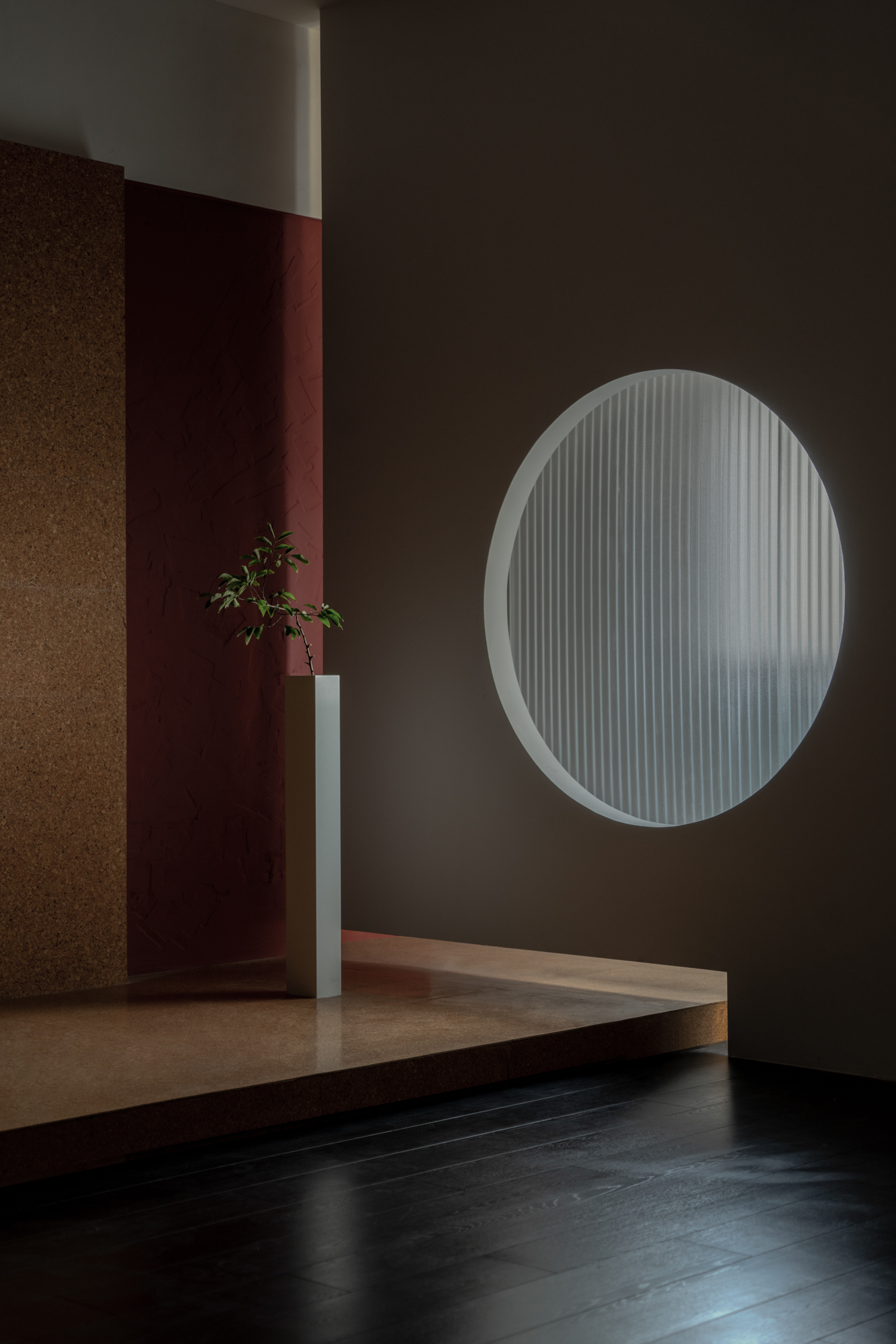
二分“园”好比体内的横隔分开胸腔与腹腔,这种对立统一的关系,促使我们思考瑜伽与空间彼此的关系与联结。在空间开合转换间、在闲散游走回望间、在瑜伽习练冥想间,希望使用者能感受到行望游走的趣味,空间转合明亮与阴翳的变化,让瑜伽习练者在此找到自己身体与精神的一隅。
The binary garden is like the diaphragm in the body separating the thoracic cavity and the abdominal cavity. This unity of opposites prompts us to think about the relationship and connection between yoga and space. Between the space transition of opening and closing, and amid leisurely wandering as well as yoga practice and meditation, users are expected to feel the fun of lingering and wandering, the transition of the space transition as well as the changes of light and shadow, thereby finding themselves a perfect corner here to cultivate their body and spirit.
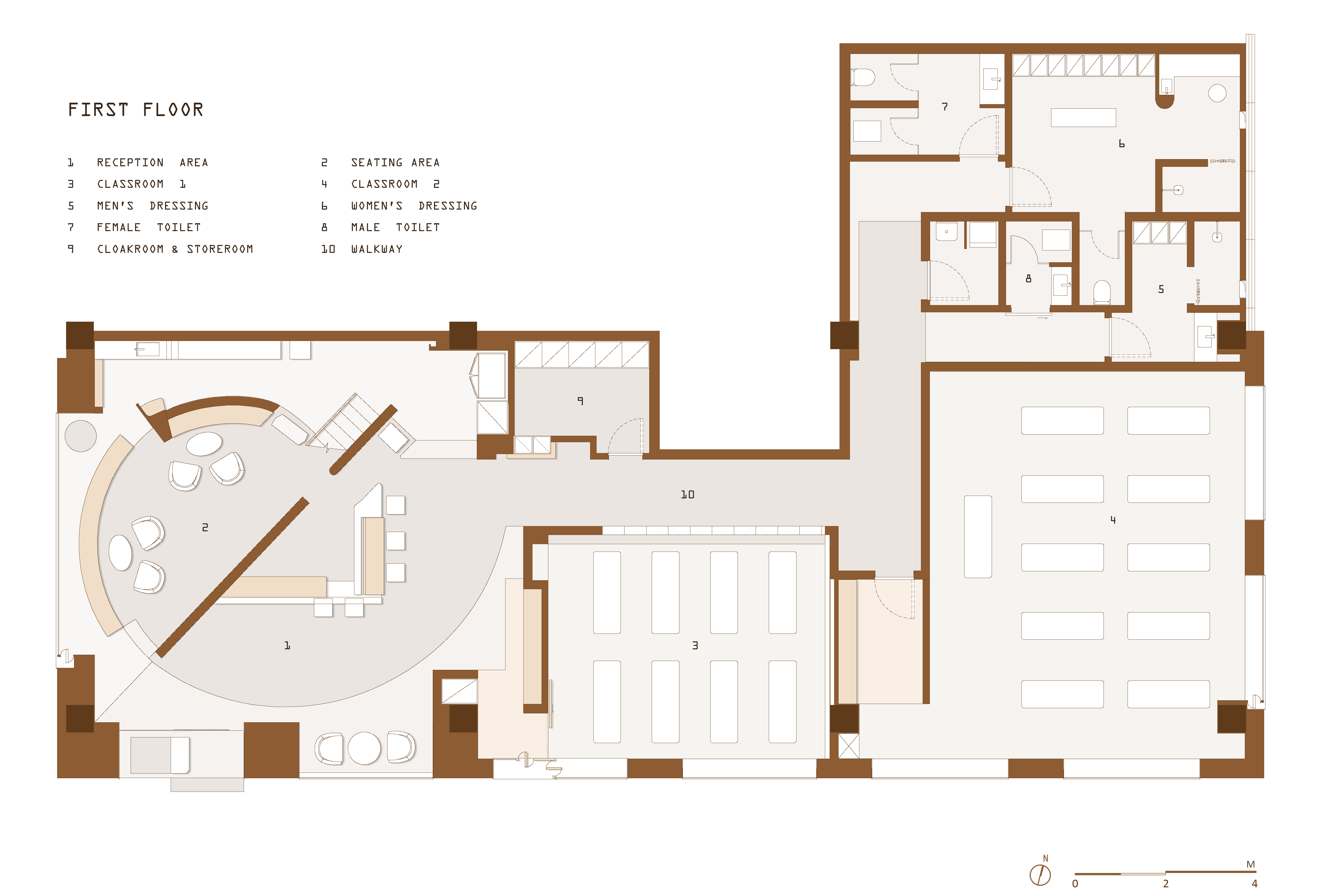

注释:
[1] 梵文术语
[2] 梵文术语,指快乐、愉悦的正面感受
[3] 原作名: The Heart of Yoga: Developing a personal prctice
[4] 出自《瑜伽之心》
完整项目信息
项目名称:一隅瑜伽艺术中心
设计单位:边界空间设计
完成年份:2022年
建筑面积:500平方米
项目地点:江苏省常州市武进区武进经济开发区七区上东城13幢
主创建筑师:黄三秀
设计团队:黄三秀、宋帅奇、高巍东、施甫、孙洁、董智虹
委托方:一隅瑜伽
施工方:常州金逸装饰
材料:软木、水磨石、金属、阳光板、树脂板、
品牌:GUBI、Herman Miller、Fritz Hansen、Vitra、FLOS
摄影:汪敏杰
版权声明:本文由边界空间设计授权发布。欢迎转发,禁止以有方编辑版本转载。
投稿邮箱:media@archiposition.com
上一篇:路易斯·康印度管理学院再度面临拆除,校方表示将停止修复
下一篇:添上一抹活力黄:西安未央168商业街区露台改造 / 原筑景观